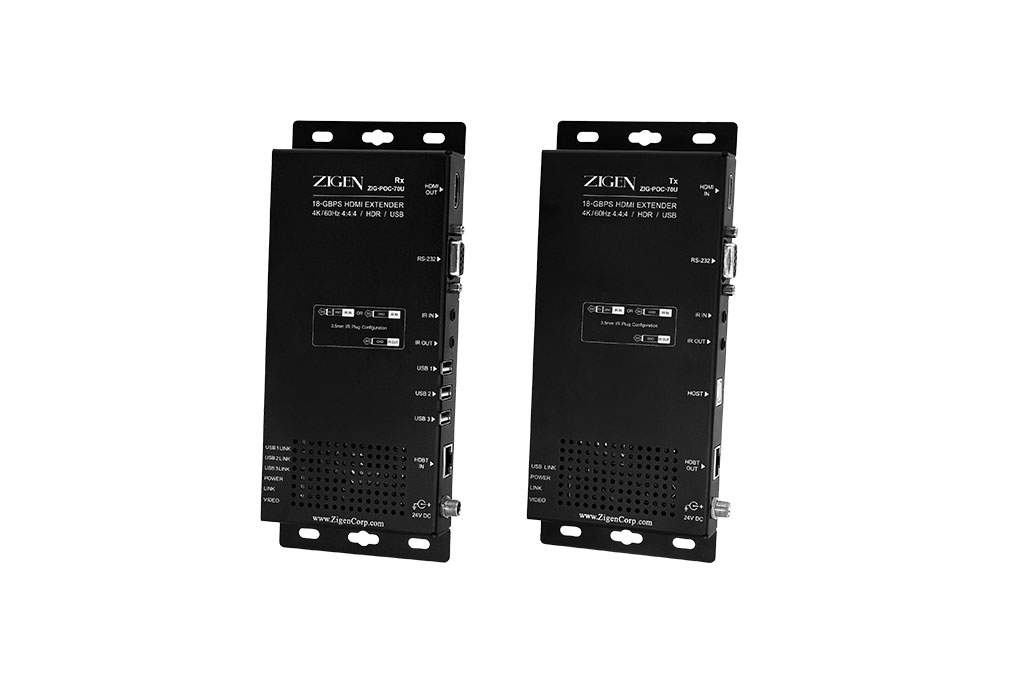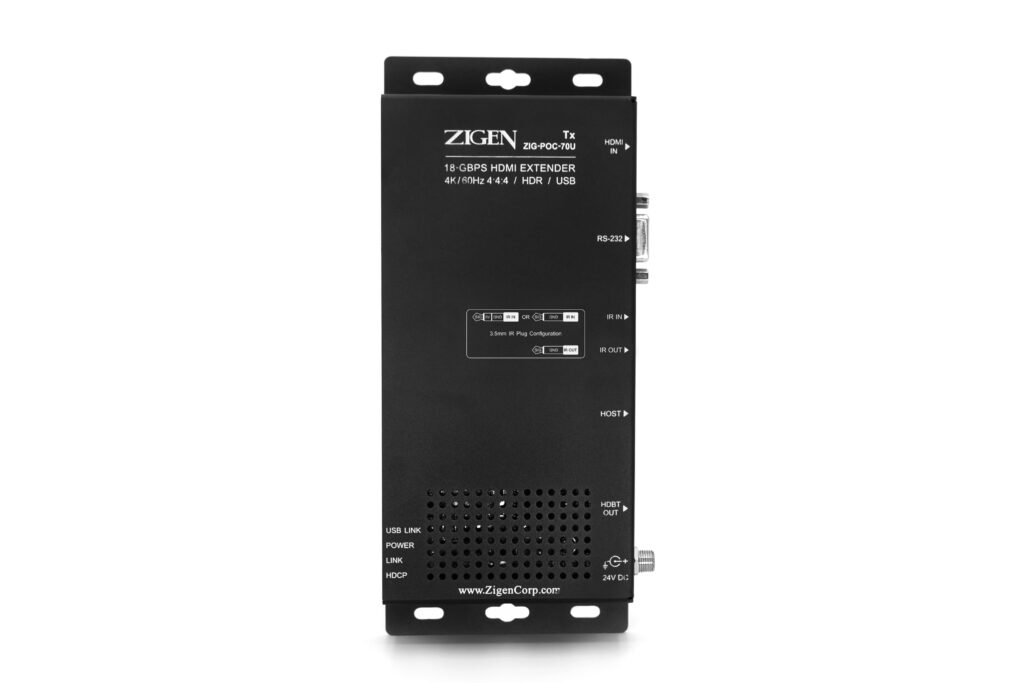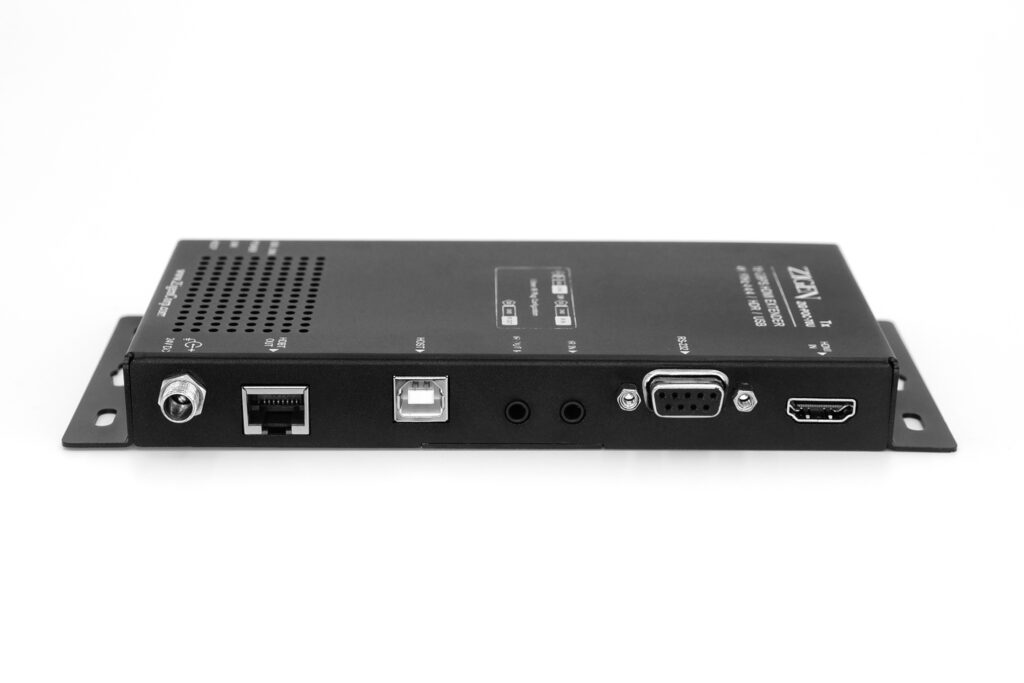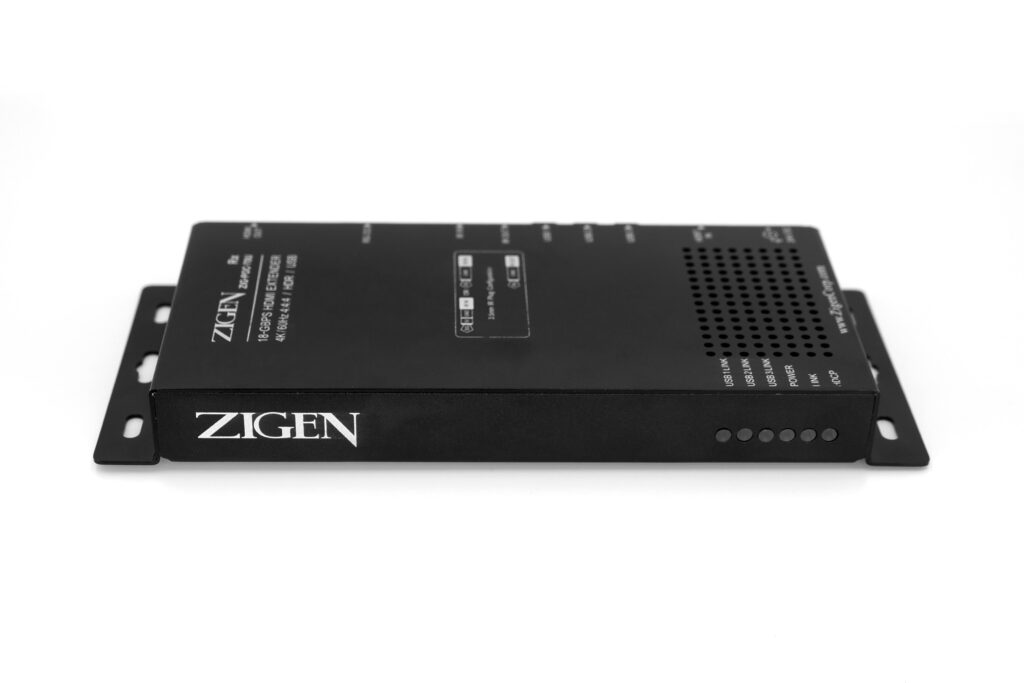ZIG-POC-70U
18-GBPS HDMI Extender with Bi-Directional Power




18-GBPS HDMI Extender with Bi-Directional Power
The ZIG-POC-70U is an ultra-thin HDMI2.0 and USB 2.0 Extender set consisting of a transmitter and receiver. The device extends 1080p/4K HDMI 2.0 with USB-2.0, bi-directional IR, and RS-232 over single CAT-6a cable up to 70m/40m using PoC. The receiver contains a 3-port USB hub to support various KVM applications.
This extender is equipped with visually lossless video compression technology called (DSC) to ensure HD transmission of HDR-10 and 4K@60Hz/4:4:4 over CAT-6a cable.
Zigen’s POC and PoE-PRO line of HDMI extenders use a proprietary compression/decompression engine to allow high bit rate video resolutions, such as 4K60 4:4:4, to pass through the 9-GBps bandwidth limitation of HDBaseT. The transmitting device is configured to compress the incoming video stream to a reduced rate HDMI signal, while the receiving device is configured to decompress the original video stream back to normal rate HDMI with minimum distortion and artifacts. DSC type compression engines utilize intelligent predictive methods, such as Median-Adaptive, Block Prediction, Midpoint Prediction, and Flatness Detection, to efficiently perform data bandwidth reduction. Zigen’s extenders strictly pass raw HDMI signals up to 4K/30Hz 4:4:4 without any compression, while supporting all color bit depths. Compression is only used for resolutions from 4K/30Hz 4:4:4 to 4K60Hz 4:4:4.
Competing product’s implementation of “Visually Lossless Compression” or “Invisible Compression Technology (ICT)” use Color Space Conversion (CSC) to reduce high bit rate video resolutions from 4:4:4 down to 4:2:0 in order to pass the incoming video down to the 9-GBps HDBaseT limit. While “CSC” and “ICT” is technically not a compression/decompression scheme, these methods down-sample or throws away in upwards of 4 times the color information of the original 4:4:4 image. “CSC” and “ICT” works by taking the original full bandwidth 4:4:4 and halves the horizontal color resolution to 4:2:2, then 4:2:0 takes it down even further by halving both horizontal and vertical color resolutions resulting in 4 times less color information. These competing products will utilize “Interpolation” to bring HDMI back to normal rate, but once the color resolution is thrown away, there is no way of getting it back. Below are comparisons between the original 4:4:4 image and the resulting decimated 4:2:2/4:2:0 images.
DSC type compression engines outperform downscaling 4:2:0 type methodologies, verified through rigorous testing by experts on a variety of large-panel displays and mobile devices. Test contents included White Noise, Zone Plates, Multiburst, High-Density Subpixel Rendered Text, Computer and Mobile Device Screen Captures, Photos, and Videos. Some organizations selected content to emphasize artifacts based on mathematical analysis of the compressed sources and DSC type algorithms outperformed the competition based on picture quality tests, and was visually lossless for all tested images at 8 bits/pixel.
For the ultimate 18-GBps extender without any compression whatsoever, take a look at Zigen’s OFL-1000 optical extender. Extend uncompressed HDMI up to 4K/60Hz 4:4:4 exceeding thousands of feet, limited only by the type of fiber used.
Zigen’s POC and PoE-PRO line of HDMI extenders use a proprietary compression/decompression engine to allow high bit rate video resolutions, such as 4K60 4:4:4, to pass through the 9-GBps bandwidth limitation of HDBaseT. The transmitting device is configured to compress the incoming video stream to a reduced rate HDMI signal, while the receiving device is configured to decompress the original video stream back to normal rate HDMI with minimum distortion and artifacts. DSC type compression engines utilize intelligent predictive methods, such as Median-Adaptive, Block Prediction, Midpoint Prediction, and Flatness Detection, to efficiently perform data bandwidth reduction. Zigen’s extenders strictly pass raw HDMI signals up to 4K/30Hz 4:4:4 without any compression, while supporting all color bit depths. Compression is only used for resolutions from 4K/30Hz 4:4:4 to 4K60Hz 4:4:4.
Competing product’s implementation of “Visually Lossless Compression” or “Invisible Compression Technology (ICT)” use Color Space Conversion (CSC) to reduce high bit rate video resolutions from 4:4:4 down to 4:2:0 in order to pass the incoming video down to the 9-GBps HDBaseT limit. While “CSC” and “ICT” is technically not a compression/decompression scheme, these methods down-sample or throws away in upwards of 4 times the color information of the original 4:4:4 image. “CSC” and “ICT” works by taking the original full bandwidth 4:4:4 and halves the horizontal color resolution to 4:2:2, then 4:2:0 takes it down even further by halving both horizontal and vertical color resolutions resulting in 4 times less color information. These competing products will utilize “Interpolation” to bring HDMI back to normal rate, but once the color resolution is thrown away, there is no way of getting it back. Below are comparisons between the original 4:4:4 image and the resulting decimated 4:2:2/4:2:0 images.
DSC type compression engines outperform downscaling 4:2:0 type methodologies, verified through rigorous testing by experts on a variety of large-panel displays and mobile devices. Test contents included White Noise, Zone Plates, Multiburst, High-Density Subpixel Rendered Text, Computer and Mobile Device Screen Captures, Photos, and Videos. Some organizations selected content to emphasize artifacts based on mathematical analysis of the compressed sources and DSC type algorithms outperformed the competition based on picture quality tests, and was visually lossless for all tested images at 8 bits/pixel.
For the ultimate 18-GBps extender without any compression whatsoever, take a look at Zigen’s OFL-1000 optical extender. Extend uncompressed HDMI up to 4K/60Hz 4:4:4 exceeding thousands of feet, limited only by the type of fiber used.
Join our mailing list to receive the latest news and updates from our team.
Thanks for subscribing!